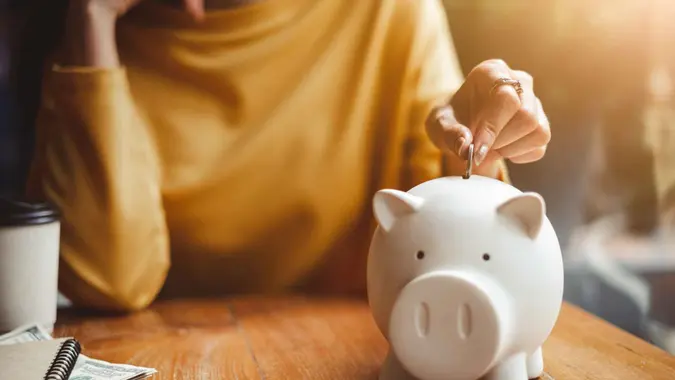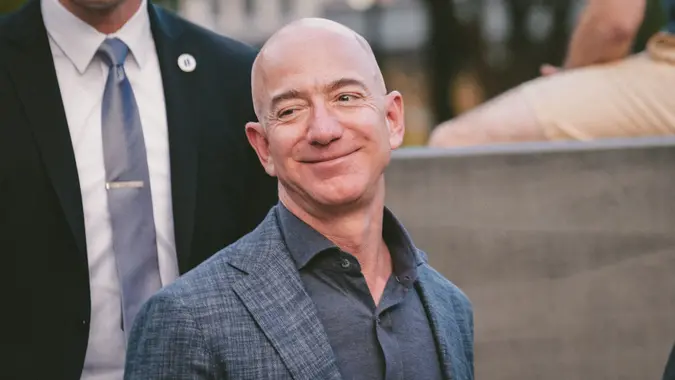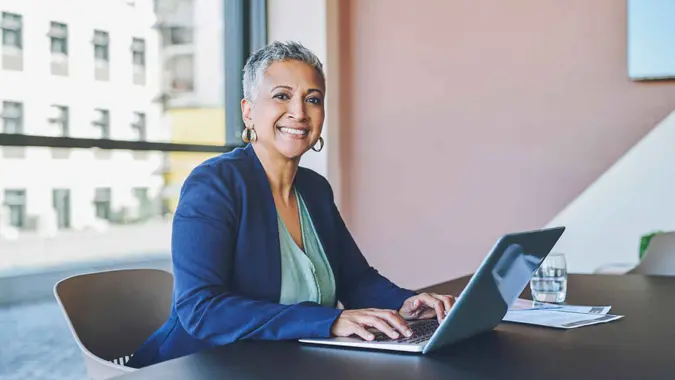How Amazon Became the World’s First Trillion-Dollar Retailer

Commitment to Our Readers
GOBankingRates' editorial team is committed to bringing you unbiased reviews and information. We use data-driven methodologies to evaluate financial products and services - our reviews and ratings are not influenced by advertisers. You can read more about our editorial guidelines and our products and services review methodology.

20 Years
Helping You Live Richer

Reviewed
by Experts

Trusted by
Millions of Readers
Amazon founder and former CEO Jeff Bezos is no stranger to turning a profit. In fact, Amazon, the once small online bookstore turned trillion-dollar company, has been on a skyrocketing, money-making trajectory since it started over 30 years ago.
Though Bezos stepped down from his CEO position in 2021, he had already accomplished what few ever imagined — creating a world where online shopping and overnight door-to-door delivery of everything from books and clothing to groceries and technology is not just a perk, but the expectation. Having an estimated $2.2 trillion market cap doesn’t hurt either.
Amazon Experiences Rapid Growth Early On
This current Wall Street powerhouse shows no signs of slowing down its global takeover. So, how did Amazon get where it is today? To understand one of the biggest online retailers in the world, take a look at some of its milestones in online shopping — where the company has led the way.
When you think of the super-rich, some of the first people that come to mind are probably Elon Musk, Donald Trump or Warren Buffett alongside Bezos. However, when Bezos founded Amazon as an online bookseller in 1994 in the garage of his rented home in Washington with almost $250,000 start-up capital from his parents, he probably never imagined he’d be their contemporary.
In just two months the company was making $20,000 per week in book sales and reinvesting that back into the business, putting it on the path to eventually join the trillion-dollar club.
Amazon Gets Funding, Expands Reach
Bezos received $8 million in series A funding from investors in 1995. In 1996, the company introduced its affiliate program, enabling bloggers, website owners and other influencers the ability to earn a bit of extra cash off of Amazon sales.
In 1997, the site launched its first remote distribution center and introduced one-click ordering, which was unprecedented at the time, as CBS News reported.
Amazon Issues IPO, Goes Beyond Books
As it worked to expand reach and increase sales, Amazon went public in 1997 with an IPO of $18 a share. By 1999, the company’s original investors had made back returns of 55,000%, according to Fundable reports.
By 1999, Amazon was also selling DVDs, music, home improvement products, software, video games, gift items and more. In 2000, it offered free shipping on orders over $100 for the first time ever, in a program that would become the predecessor to Amazon Prime, where many items ship for free the next day.
Prime Time for Amazon
In 2005, Amazon launched its subscription-based loyalty program, Amazon Prime, which gives members access to fast, free shipping and a library of movies, TV shows and exclusive programming available for streaming.
Today, millions of American households have a Prime membership, while over half of Amazon shoppers worldwide pay for the service monthly. This is one of the big reasons why Amazon has an over-trillion-dollar valuation and Bezos himself is on the Bloomberg Billionaires Index — currently ranked as the second richest person on the planet behind Musk.
Amazon and Its Record-High Market Cap
Amazon reached a record market valuation of $1.5 trillion in July 2020. Ever since, Bezos, Bill Gates, Musk, Mark Zuckerberg and more have consistently battled it out for who is the richest person in the world. Bezos, every so often, tops that list and he is currently estimated to have a net worth of $227 billion and Amazon has a value of $2.2 trillion.
 Written by
Written by  Edited by
Edited by 

























